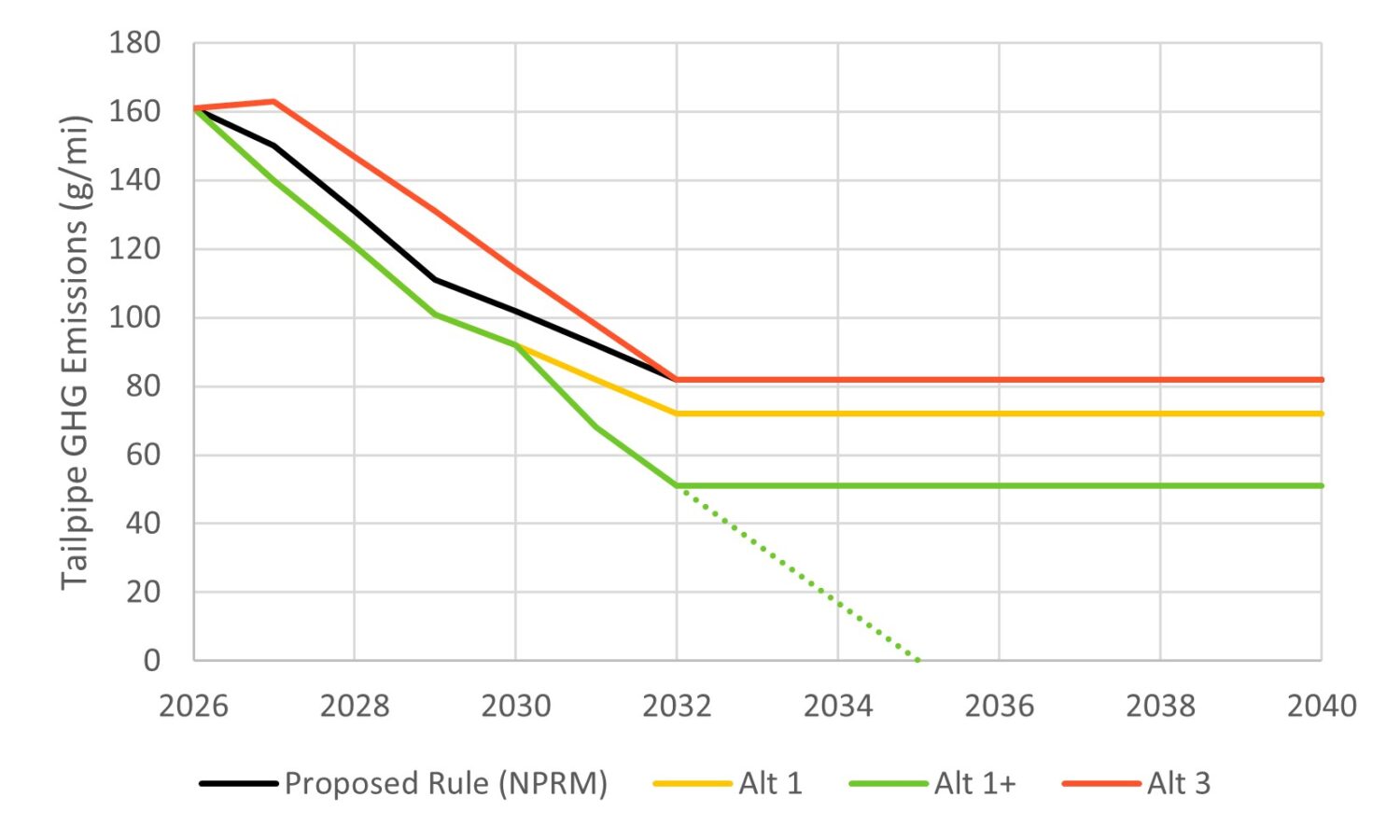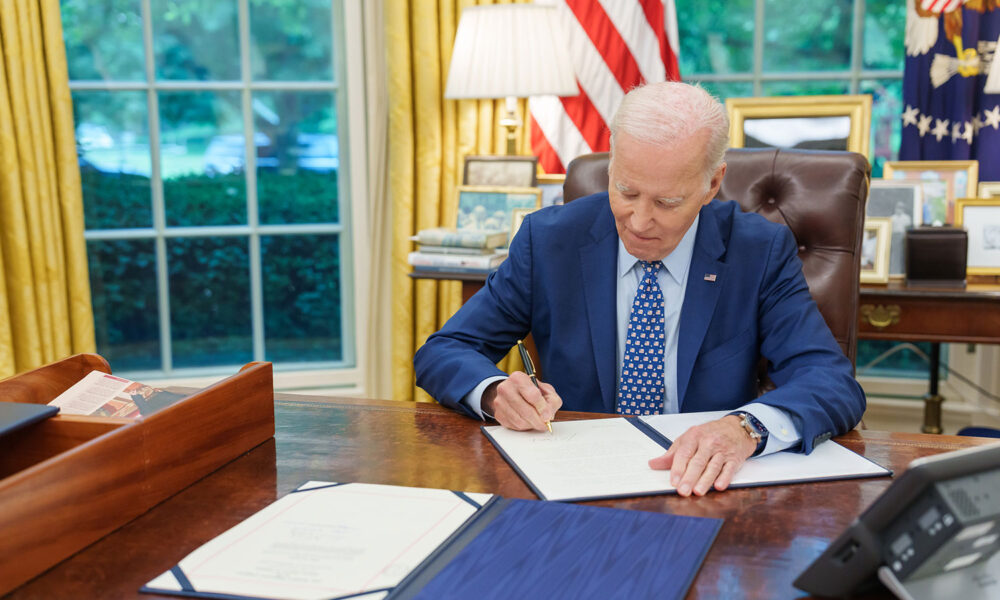The UN’s Climate Change Conference is just about to kick off in Dubai, juxtaposing the powerful political power of the fossil fuel industry and the desperate need to reduce oil and gas usage as we face an ongoing climate crisis. With the petroleum-dominated transportation sector the leading source of heat-trapping emissions in the United States, it’s a great opportunity to look at the Biden administration’s progress on cleaning up passenger cars and trucks and what we should look for in the coming year.
This year, the Environmental Protection Agency (EPA) and National Highway Traffic Safety Administration (NHTSA) proposed new emissions and fuel economy standards (respectively) for model year 2027-2032 passenger cars and light trucks (sedans, utility vehicles, pickups, etc.). We expect those rules to be finalized early next year, and automakers have been pushing the agency to weaken its proposals.
The gap between industry’s asks and what is needed to address climate change is staggering:
Recent analysis shows that the additional emissions associated with finalizing a weaker proposal on passenger cars would be even greater than the entire reductions expected from EPA’s recent proposal to address power plant emissions.
Below I walk through who’s asking for what, and what’s at stake.
These rules must accelerate the ongoing transition towards electrification
As my colleague recently wrote, this year has seen a continued rise in sales of electric vehicles, on pace for over a million fully electric vehicles sold this year in the US, indicating the transition to electrify the passenger car market is well underway. Nowhere is this clearer than in the state of California, where EVs now make up one in four new vehicles sold, but California is not alone: Florida, Texas, New York, and other major markets are also accelerating
State policies have helped start the EV revolution, but we need the federal government involved to accelerate that transition nationwide and put us on track to meaningfully address climate change, which means electrifying all new light-duty vehicle sales by 2035. But it is precisely this pace of change that has the auto industry pushing back hard on EPA’s proposed rules.
EPA considering a range of alternatives
EPA proposed standards that would aim to reduce greenhouse gas tailpipe emissions by about 70 percent compared to today’s vehicles (or about a 60 percent reduction from the 2026 standards currently on the books), to a lab certification level of emissions of 82 grams per mile (g/mi) by 2032. One key part of the rule is closing a loophole for off-cycle credits that has eroded the stringency of the current standards over time.
In addition to their proposal, the agency considered three alternatives: one which is 10 g/mi more stringent (Alt 1), one which is 10 g/mi less stringent (Alt 2), and one which arrives at the same end point (82 g/mi) but does so more slowly than proposed (Alt 3), increasing the emissions impact compared to the proposal.

The Union of Concerned Scientists, as well as a number of other non-governmental organizations (NGOs) including consumer, environmental, faith, and environmental justice/community-based organizations, asked EPA to move even more aggressively than Alt 1—while the proposal moves forward with action commensurate to address heat-trapping emissions through 2030, it eases up on the pace of improvement and falls short of the trajectory needed to electrify new vehicles sales by 2035. Therefore, we pushed EPA not to ease up after 2030 as it has, with what we’ve called Alt 1+.
Unsurprisingly, automakers advocated for weakening the proposed greenhouse gas standards—Ford asked for Alt 3, while other automakers pushed for a combination of the slower pace of Alt 3 and a weakened stringency like Alt 2. Across the board manufacturers advocated for additional loopholes that would further erode the benefits of any standard.
Automakers have also pushed for weakening the newly proposed tailpipe emissions standards for particulate matter (PM) included in EPA’s “multi-pollutant” rule. These proposed PM standards represent an important step to address public health by cleaning up gasoline-powered vehicles as we make the transition to EVs by requiring gasoline particulate filters, which are already ubiquitous in Europe and China. However, automakers are pushing to weaken the stringency and test requirements of the proposal sufficiently such that this common-sense emissions-reducing technology remains on the shelf in the U.S.
EPA’s proposal underestimates what is possible
A lot of the press coverage of EPA’s proposal presented the agency’s analysis as though it were a guarantee of the future, but one of the key reasons UCS is pushing for Alt 1+ is because EPA has underestimated what is achievable in this time frame. Most notably, EPA understated the gains that can be made from gasoline-powered vehicles. In fact, EPA’s analysis assumes that a large share of gasoline-powered vehicles emit more heat-trapping emissions over time.
If we simply make the reasonable assumption that automakers aren’t going to make cars worse over time, that alone is enough to justify the agency’s stronger Alt 1 standard. But automakers can do even better than that because EPA’s modeling shortchanged the combustion engine technologies available today, meaning that not only have they mischaracterized how the technologies will be deployed, but they’ve underestimated the emissions reductions deployment would bring.
These shortcomings mean that automakers could do much more with their gasoline-powered fleet than EPA supposes, so if EPA doesn’t strengthen its rule, we will see far fewer EVs on the road than the modeling accompanying their proposal suggests. Manufacturers are setting EV sales records and planning the investments needed for an electric future, but we’ve also seen them willing to continue to kick the can down the road for short-term profit—that must end now.
Climate action requires more than what industry would prefer
As EPA looks to finalize its next regulation, it’s important to understand what’s at stake. Aggressive action is needed to address climate change and transportation pollution, and every new batch of regulations results brings the same ol’ song and dance from opposing automakers. The impact of heeding their objections rather than moving forward with what is feasible and necessary would be a serious step back in climate action.
| Policy Scenario | Cumulative Reductions, 2026-2040 | Cumulative Reductions, Relative to Proposal |
| (million metric tons CO2-equivalent) | ||
| EPA Proposal | 1,544.5 | — |
| Alternative 1+ | 2,018.1 | +473.6 (+31%) |
| Alternative 3 | 1,373.2 | -171.3 (-11%) |
Analysis by consulting firm ERM shows that through 2040, the UCS/NGO alternative (Alt 1+) would cut heat-trapping emissions by an additional 31 percent compared to EPA’s proposal. On the other hand, Alt 3 would increase emissions by 11 percent compared to the proposal. Since Alt 3 is stronger than what automakers have asked for, which includes additional loopholes not part of Alt 3, this means the analysis actually underestimates the gap between the two positions. And that gap results in some significant impacts.
In total, the difference between Alt 1+ and Alt 3 amounts to 645 million metric tons of heat-trapping emissions through 2040. To put that in perspective, this is greater than ALL of the reductions from the recently proposed power plant rule through 2042 (617 million metric tons).
These rules are about more than just the climate
Because these rules also include new standards for smog-forming emissions (nitrogen oxides [NOx] and volatile organic compounds [VOCs]) as well as the emissions of soot, or particulate matter (PM), EPA’s new rules are about more than just the climate. While EPA did not consider additional alternatives in its NOx+VOC or PM standards, UCS and others pushed for stronger NOx+VOC standards that would reflect what is feasible both from increasing electrification and cleaner gasoline-powered vehicles.
Thanks to increased stringency, modeling projects that by 2040 there would be an additional 18 million EVs on the road if Alt 1+ were finalized instead of Alt 3. Combined with the increase in stringency to the tailpipe emissions standards for NOx+VOC, this would reduce premature mortality from passenger cars and trucks by an additional 26 percent over the 2026-2040 time period, saving hundreds more lives and reducing trips to the ER and missed days from work and school.

These EVs result in significant net savings for drivers as well. In 2040, even including relevant technology and charger costs, Alt 1+ would save drivers $86 billion—that’s $24 billion more than Alt 3. Combined with improved air quality and the climate, Alt 1+ stands to generate $887 billion in social benefits through 2040, a sizeable increase from both the proposal ($679 billion) and Alt 3 ($628 billion).
EPA must side with the public rather than industry
The auto industry doesn’t care about emissions or public health—they care about selling cars. Reining in the harms of our car-centric transportation system is the responsibility of policymakers, including the regulators at EPA now facing a choice as they look to finalize the next phase of emissions standards for passenger cars and trucks.
This choice is clear: to the extent that we continue to rely upon privately owned vehicles, we need to eliminate their tailpipe emissions as we simultaneously reduce emissions from the electric grid powering those vehicles. Automakers want to continue to slow that progress.
The cost of listening to the auto industry instead of doing what is both feasible and necessary to protect public health and the environment would equate to wiping out the entire benefit of a major rulemaking governing heat-trapping emissions from new power plants. We cannot afford such harm in the middle of a climate crisis.
EPA’s proposal was a good step, but the facts support going stronger. EPA must finalize a rule that meets the moment—now is the time for decisive action.

